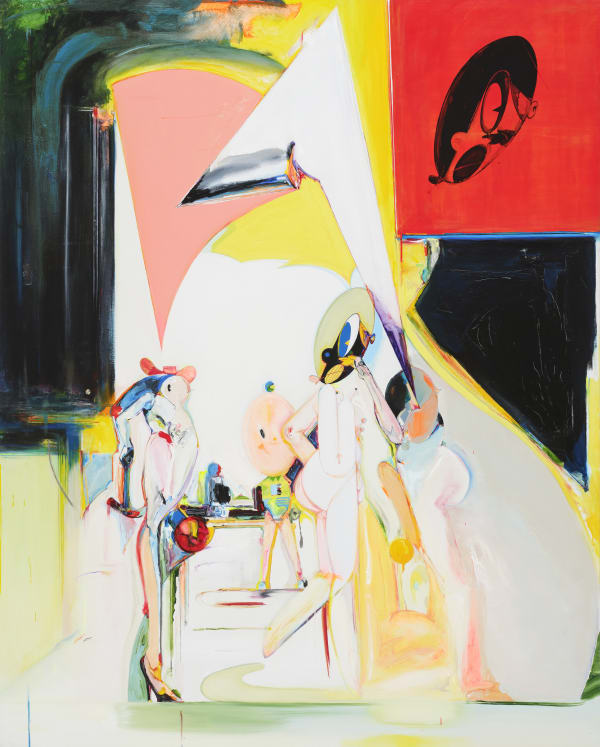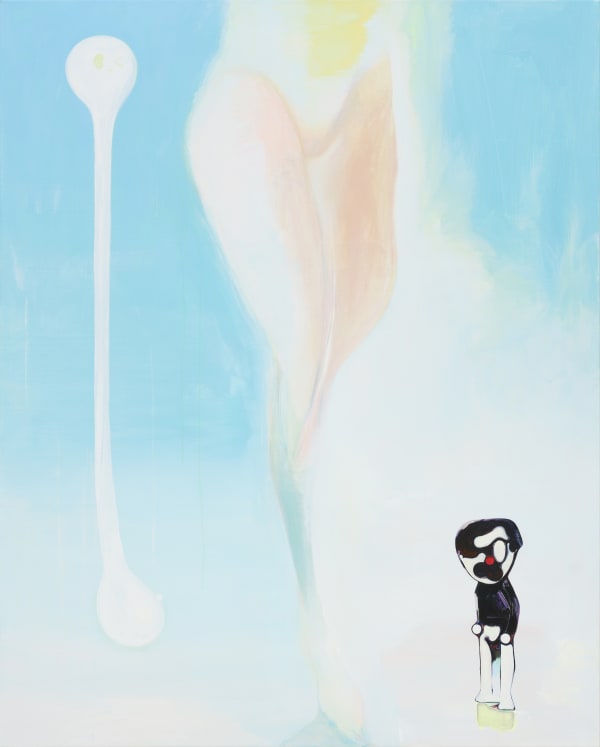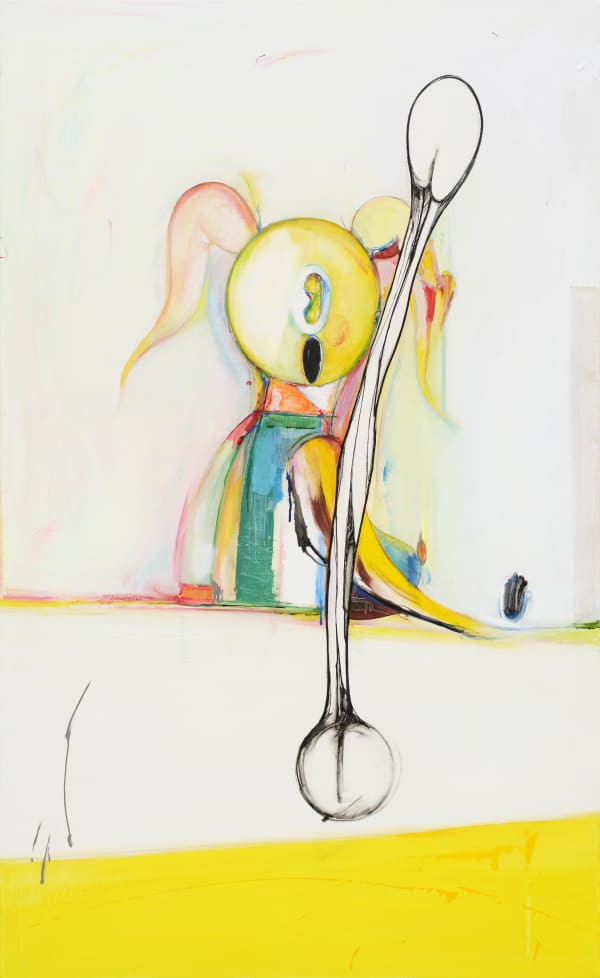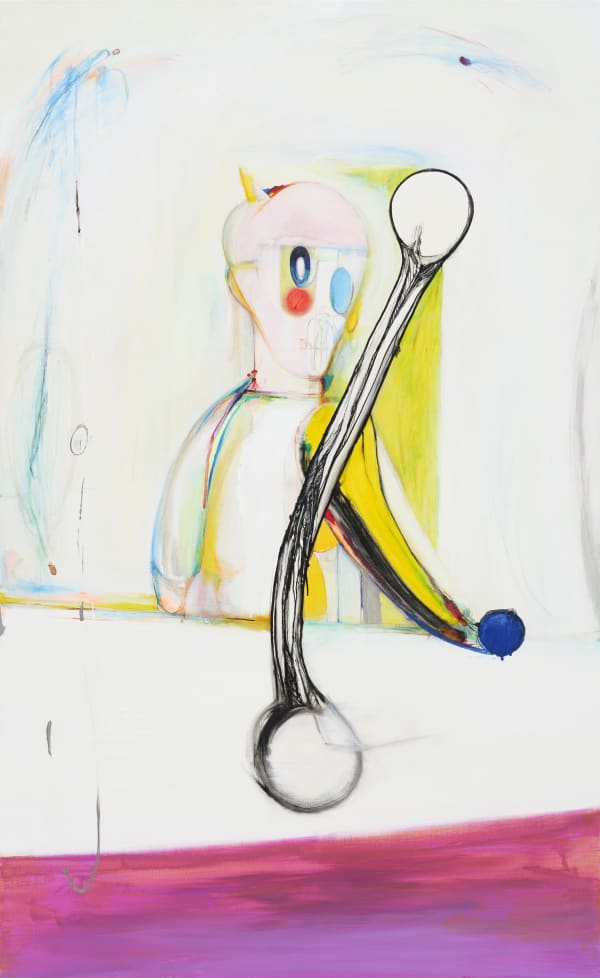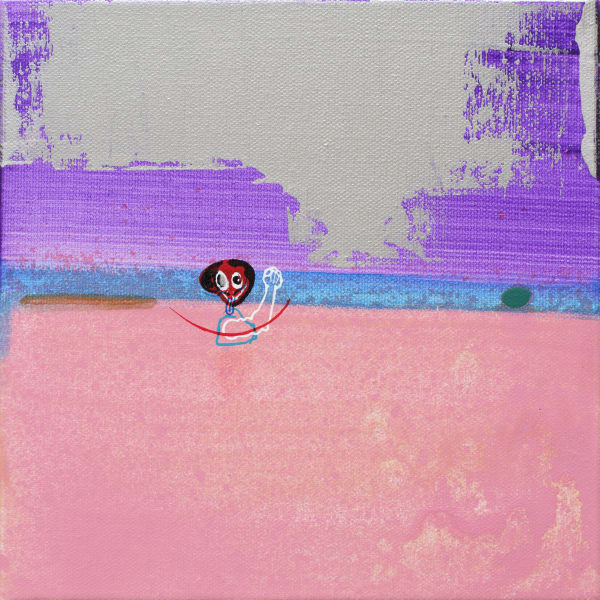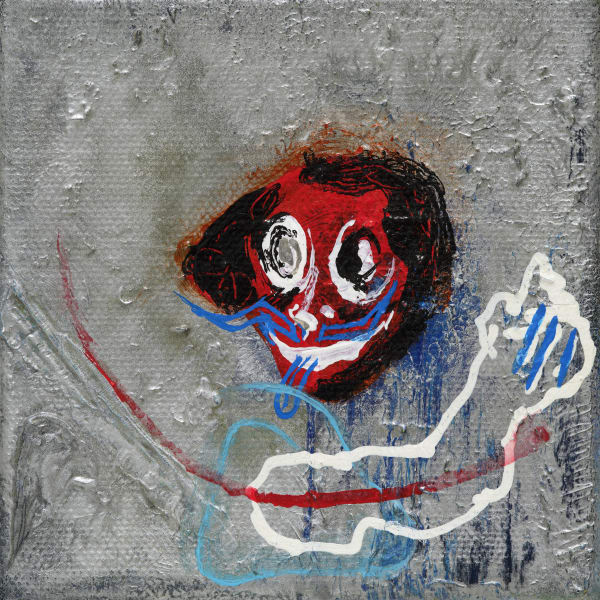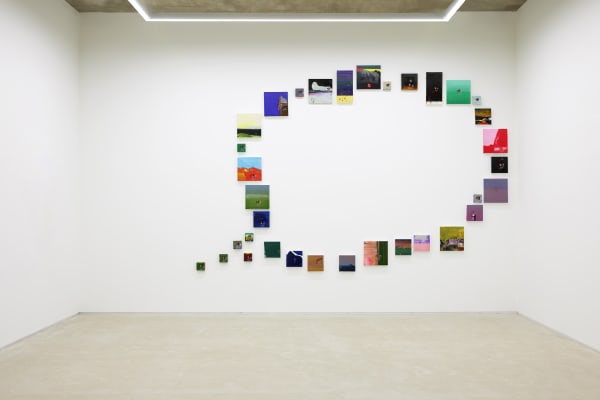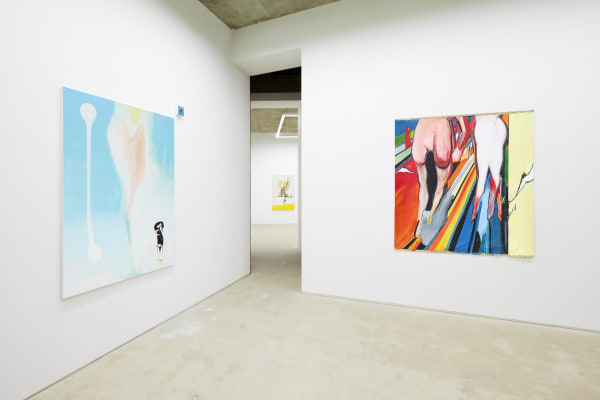조용함이여! Oh! Silence: 유창창 Changchang Yoo
유창창은 작업할 때 영상이나 음악을 항상 틀어 놓는다고 한다. 그런데 어느 순간 플레이가 정지되어 고요해질 때, 작가는 그 순간이 너무 ‘시끄럽다’고 말한다. 적막 속에서 작가 내면의 여러 생각과 감정들이 떠들어 대는 것이다. 그 생각과 감정의 정체는 무엇일까. 그는 그것을 한 사람이 살아온 시간의 축적인 ‘인생’이라고 조심스레 대답했다. 이번 전시는 소리가 꺼진 조용한 상태에서 그의 내면에서 떠오른 여러 감정을 기폭제로 삼은 그림을 선보인다. 전시 제목인 <조용함이여!>는 경외이자 감탄이자 탄식의 표현이다.
고요한 상태에서 떠오른 작가의 감정은 하나의 에너지로 발동하여 그림 속 캐릭터로 발현된다. 하지만 내면에서 발동하는 감정이 시시각각 다르듯 에너지의 모양과 크기는 다 다르고 캐릭터 역시 각기 다른 형태와 표정을 갖는다. 그는 캐릭터가 어떤 공통된 성향을 보일 수 있지만, 매번 그리는 캐릭터들이 다 다르게 보이길 원한다고 말한다. 인간은 내면에 여러 가지 성격과 말로 다 설명할 수 없을 만큼 복잡한 감정을 가지고 있다. 작가는 자신 안에 존재하는 500개, 1,000개의 이야기와 감정에 그 나름의 캐릭터를 만들어 주고 싶었던 것이다. 아니 그렇게 존재할 수밖에 없다.
<왜!> 시리즈는 동일한 상황에 다르게 반응하는 여러 캐릭터를 보여준다. 그림 속 캐릭터들은 뒤를 돌아보면 화면 밖으로 ‘왜’라고 말하는 듯하다. 이 작품은 액션과 리액션의 관계를 보여준다. 누군가가 말을 걸었을 때 테이블 너머의 인물이 뒤를 돌아보면서 대답한다. 그런데 대답하는 이들의 표정이 제각각이다. 깜짝 놀라거나 화를 내거나 궁금해하거나…. 작가는 동일한 상황에서 예상할 수 있는 다양한 리액션을 캐릭터의 표정으로 보여준다. 똑같은 말이지만 발화하는 이의 감정과 목소리 톤과 상황이 각기 다른 뉘앙스를 만들어 내고 있다. 관람자와 화면 속 캐릭터 사이에 뼈가 가로막고 있는데, 그는 관람자와 이미지 사이에 하나의 ‘벽’을 두고 싶었다고 한다. 캐릭터의 표정에 몰입하고 있을 때 이질적인 대상은 순간 화면으로부터 관람자를 멀어지게 한다. 유창창은 이것이 그림을 더 풍요롭게 하는 장치라고 생각한다.
작가가 캐릭터를 강조하는 이유는 그것이 그림의 시작점이기 때문이다. 그는 작품을 미리 계획하지 않는다. 내면의 에너지는 캔버스 위에서 캐릭터로 발현되고 그 캐릭터들은 화면 위에서 스스로 작동하면서 다른 캐릭터들을 자연스럽게 불러들인다. 화면이라는 무대 위에 인물들이 배치되고 부수적으로 배경과 색이 더해지면 하나의 미장센이 만들어진다. 미장센들은 때론 아름답거나 불안하거나 슬프거나 기쁘거나 외설적이거나 유쾌하다. 그리고 이 미장센은 스토리를 만들어 낸다. 하나의 캐릭터로부터 출발하여 하나하나 살을 붙여가는 것이 그의 작업 과정이다. 그러는 와중에 작가는 자연스럽게 제목이 떠오른다고 한다. 그래서 작품의 제목은 불현듯 떠오른 미장센의 설정이나 그 속에 등장하는 캐릭터들의 대사와 같다.
<포옹>은 서로 끌어안고 있지만 다른 곳을 바라보는 두 인물을 보여준다. 어깨를 그리는 걸 좋아하는 유창창은 캔버스에 기역자의 선을 그었다. 그러다 보니 사람의 얼굴을 그리게 되었다. 그 모습이 마치 누군가를 안고 있는 모습 같았다고 한다. 이렇게 하나의 추상적인 선에서 인물로 그리고 한 명에서 두 명의 인물이 등장하게 됐다. 그는 두 명의 인물을 완성했을 때, 작품 제목을 ‘포옹’해야겠다고 결정한다. 하지만 포옹에도 여러 상황이 있다. 격려의 포옹, 인사의 포옹, 애정의 포옹. <My Picnic>은 두 명의 여자와 한 명의 남자가 피크닉을 즐기며 왁자지껄 떠드는 모습을 보여준다. 그런데 작가는 그들이 피크닉을 하는 곳이 바로 무덤이라고 말한다. 무덤 위에서 그것도 나체로 피크닉을 즐기고 있는 것이다. 이 미장센들의 장르가 멜로인지 판타지인지 코미디인지 공포인지 모호하다. 작가는 그림이 여러 장르가 뒤섞인 영화처럼 보였으면 좋겠다고 말한다. 아마도 그것은 블랙코미디에 가장 가까울 것이다.
복잡 미묘한 유창창의 그림은 그의 혹은 모든 인간의 복잡한 내면을 반영한다. 무엇이라고 정의할 수 없는 그 감정들은 단지 순간적인 감정의 문제가 아닐 것이다. 그동안 축적된 경험과 나이테가 상황을 복잡 미묘하게 끌고 간다. 작가는 이것을 정제하고 명료화하기보다는 있는 그대로를 보여준다. 그림 속의 상냥하지는 않지만 매력적인 캐릭터, 복선으로 가득한 미장센, 무드를 전복시키는 예상 밖의 색감은 잔인하지만 귀엽고 우울하지만 밝고 무섭지만 우스꽝스럽고 불안하지만 아름답다. 세련되지는 않지만 에너제틱하다.
Changchang Yoo works with video or music playing in the background. When his set playlist of songs or sequence of videos play through and the studio is abruptly filled with silence, he encounters a cacophonous negative wall of sound that quickly disturbs his inner silence. He becomes overcome with thoughts and feelings that speak over each other, vying for continuity. What are they and where do they come from? Yoo cautiously answers both with “something accumulated throughout my life”.
All Yoo’s paintings this exhibition flow and swell from the monsoon of voices that wash over him in moments of broken silence. His exclamatory exhibition title <Oh! Silence> eddies in pools of awe, admiration, and lament. The artist's inner dialogue comes forth as a singular character manifestation on canvas. However, the form, expression, and energy of those characters vary. Some share certain traits, but the artist intends for them to be individual every time. The self is more likely to be a multiplicity of selves, each with personalities and complex feelings that are distinct enough to be separate, but not enough to be described in words. To those selves, the artist wished to offer hundreds, maybe even a thousand stories and feelings to flesh them out as their own characters. They simply had no other way to be.
The artist’s <Why!> series of paintings show several characters reacting to the same situation, in different ways. However, that difference in retrospect is well within the interpretable breadth of pressing for “why” to someone off-screen. It is a series that spotlights the relationship between action and reaction. Someone speaks to them from across the table, and they each look back with a response, but their expressions are not the same. Emotions and responses such as surprise, anger, and curiosity trace the range of possible reactions to the same situation. Perhaps the same words are spoken but with different inflections and tenor, earning these differently nuanced responses. A femur-like bone hinders a direct view of the figure on screen, as the artist wanted to create a barrier for the viewer. The foreign ashen object in the foreground immerses by creating necessary distance from the canvas, and the artist believes the distancing device enriches the painting.
Changchang Yoo explains that he emphasizes figures because they are where his paintings start. The figures start unplanned—like the rest of his work—and rely on the inner expression of characters on as they take shape on canvas. They seem to have will and agency, doing as they would on screen, spontaneously inviting other characters to join them. Mise-en-scène is French for putting on stage, and the artist’s placement of the figures on the canvas stage upon the backdrop of succeeding background and color creates exactly that: a mise-en-scène. These set stages can be beautiful, unsettling, sad, happy, obscene, or hilarious, and they always tell a story. The stage is put-on around the main character, and that character is fleshed out a stroke at a time. This process also inspires the title upon the artist, who likens them to lines of dialogue in theater plays, completing the essential of stage play.
Two figures in embrace in Hug, looking in other directions. Changchang Yoo who likes to draw shoulders, drew a right angle shaped like 7 on canvas, which led to a figure’s face. The lines appeared to be embracing someone. From an abstract line to a figure, and then from one figure to two figures, he finished the painting and decided it should be a Hug. But there is more than one hug. The embrace may be for encouragement, for greeting, for displaying affection. My Picnic shows a male and two female figures enjoying a picnic conversation with great exuberance, but Yoo has spread the picnic over a grave, and the picnicking figures are entirely disrobed. Is this put-on-stage one of tragedy or comedy? Is it melodramatic, fantastic, horrific, or simply enigmatic? The artist wished to present a scene that mixed genres. Perhaps it is closest to black comedy.
Changchang Yoo’s complex and oddly nuanced paintings reflect life; that of many of others as well as those many within him. The ineffability of those affected moments in life are bound to be more than a matter of momentary feeling. It draws from the accumulated experience of years and decades that add dimensions of complexity and nuance. The artist does not abridge or abstract them but chooses to paint them as they are. The characters in the paintings are not gentle, but they are charming. The mise-en-scènes are full of double meaning, while subversive use of unsettlingly bright colors set a mood of ghoulish peculiarity and bizarre polish. None of it is sophisticated, but what is put on stage is completely energetic.
